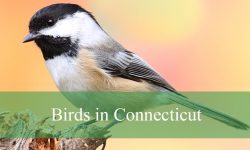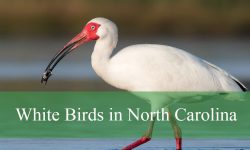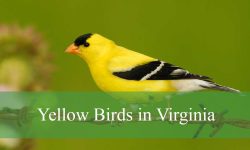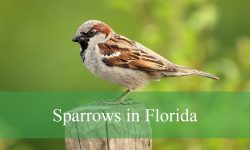Utah’s diverse ecosystems are a haven for many species of caterpillars, each contributing to the state’s vibrant biodiversity. In this article, we reveal the 41 types of caterpillars found in Utah, along with pictures and their identifying characteristics.
Different Types of Caterpillars in Utah
Buck Moth Caterpillar
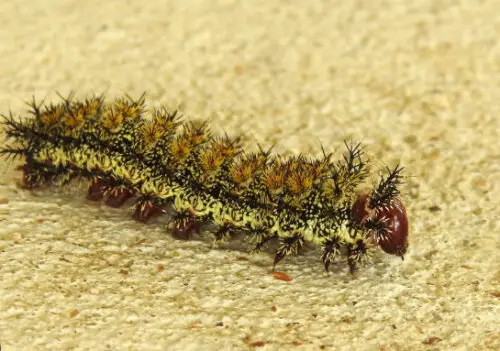
The largest stinging caterpillar in Utah is the Buck Moth Caterpillar, or Hemileuca maia as it is known in science. It has a formidable appearance due to its black body covered in tiny white dots and jagged tufts of spines. It is advised to handle these caterpillars with caution as their venomous spines can cause skin irritation and redness. They eat the leaves of scrub oak, live oak, blackjack oak, and dwarf chestnut oak. They have a recognizable round, shiny black head. To avoid unpleasant stings, keep your distance from these creepy-crawlies.
Monkey Slug Caterpillars
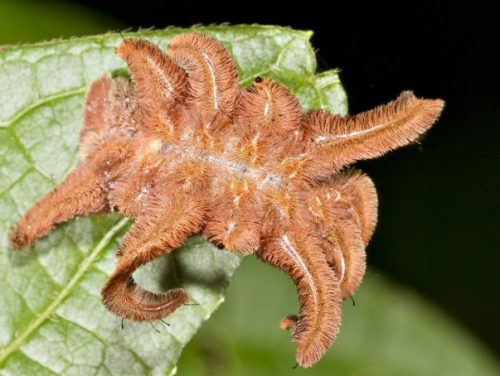
The Monkey Slug Caterpillar, or Phobetron pithecium as it is scientifically known, is an odd brown and fuzzy caterpillar found in Utah. It looks like a dead hairy spider or an old leaf, with a flattened furry body and nine pairs of strange projections along the sides. It can sting, and if handled without protective gear, its venom may cause pain. Proceed with caution. This tiny caterpillar is a rare sight in the area and can be found on apple, ash, birch, dogwood, hickory, oak, walnut, and willow trees.
Southern Flannel Caterpillar
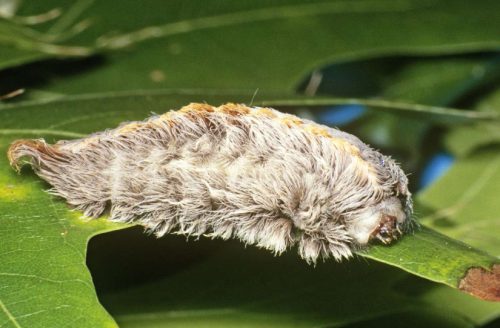
The Southern Flannel Caterpillar, also called the puss caterpillar, is a furry insect that can sting painfully from hidden poisonous spikes. Often seen in the South, especially on oak and elm trees, these grubs are poisonous and should not be touched to avoid excruciating pain. It’s also known as asp larvae, referring to the painful sting that resembles a snake bite and having a Persian cat-like appearance. Known by its scientific name, Megalopyge opercularis, it is up to 2.5 cm long, brown, and hairy, with a broad, rounded head.
White-Marked Tussock Caterpillar
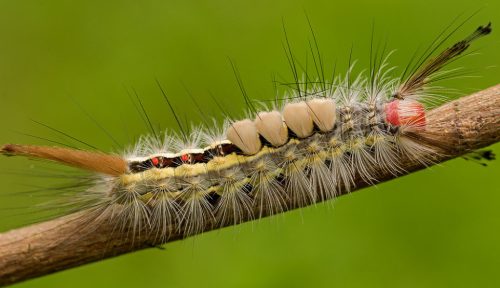
The White-Marked Tussock Moth Caterpillar (Orgyia leucostigma) has a multicolored body that is emphasized by its long white hairs and Black Tufts that resemble antennae. With its massive red head and red spots surrounding the mid-dorsal area, it’s an impressive sight. The rest of its body is mostly black, with yellow stripes providing contrast. This species eats fruit and hardwood trees like oaks and apples, though it is usually seen on rose petals and other flowers in gardens. These caterpillars eventually succumb to a communicable disease, even after numerous outbreaks.
Tobacco Hornworm Caterpillar
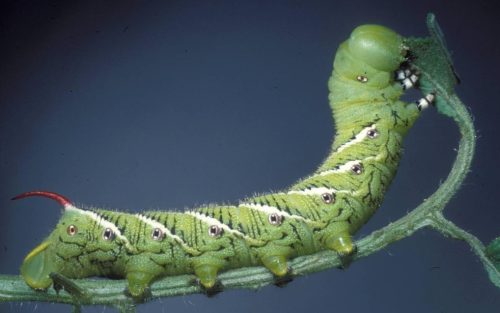
The Manduca Sexta, also called the Tobacco Hornworm, is a bright green caterpillar with white diagonal stripes down its sides and eyespot markings. Its unique orange, green, or brown rear horn can reach a length of up to 7 cm. These insects resemble tomato hornworms and feed on the foliage of tobacco, tomato, and eggplant. However, the tobacco hornworm is distinguished by its distinct diagonal stripes. Tobacco, tomato, pepper, eggplant, and a variety of decorative shrubs are examples of host plants.
Pipevine Swallowtail Caterpillar
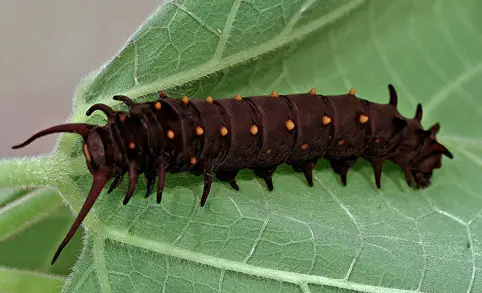
The Pipevine swallowtail caterpillar, or Battus philenor, has fleshy horns on its head, tail, and sides. Its overall color is dark brown. Two rows of vivid orange dots running the length of its back are one of its distinguishing characteristics, making identification simple. The caterpillar, which has fine hairs that give it a velvety look, is so hungry that it can grow up to be 5 cm long. Ironweed and thistle flowers are examples of host plants for this species.
Imperial Moth Caterpillar
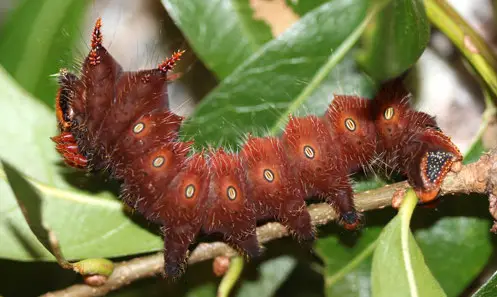
The scientific name for the Imperial Moth Caterpillar is Eacles imperialis. It has a jagged protrusion that resembles a tail and long, spiky horns on its head. It is orange-brown to dark brown or dark green in color, and it can reach a length of 7.5–10 cm. Mature caterpillars change color; they become darker and hairier, which indicates that they are ready to pupate. Found on the foliage of pine, maple, oak, sweetgum, and sassafras, this species is interesting at different stages of growth.
Io Moth Caterpillar
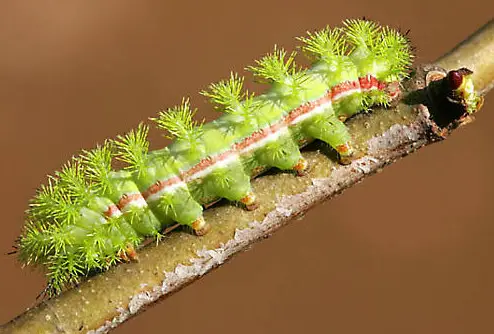
The green caterpillar with stinging hairs on its four sets of prolegs is called the Io Moth Caterpillar, or Automeris io in scientific parlance. Pale green colors and bands of vivid green hair tufts encircle its abdomen; its characteristic red and white stripes along the abdomen make identification simple. Without safety gear, handling these caterpillars can result in painful, burning rashes. These creepy insects, which can grow up to 6 cm in length, are found on plants such as blackberry, willow, redbud, hackberry, and pears.
Saddleback Caterpillar
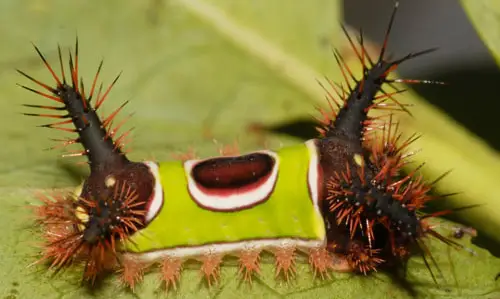
In Utah, there is a slug-like caterpillar with poisonous spikes on its back known as the Saddleback Caterpillar, or scientifically known as Acharia stimulea. It can be easily recognized by the enormous brown circle and square green patch that stick out on the central part, which resembles a saddle. Its frightening image is enhanced by stinging spines running the length of its belly and horns at either end, measuring up to 2.5 cm. When coming across this unique species, which is found on apple, asters, blueberry, maize, citrus, dogwood, elms, and grapes, vigilance is advised.
Milkweed Tiger Caterpillar
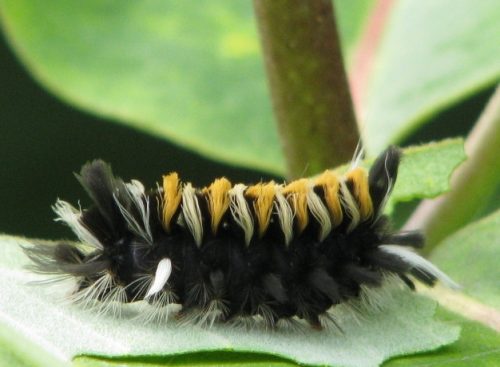
The scientific name for the milkweed tiger caterpillar is Euchaetes egle. It is a tiny, hairy caterpillar with tufts of bright orange, yellow, black, and white hair. It has a unique appearance with tan-colored tufts on its sides and a characteristic hairy brown body with orangey spiky tufts on the back. If you come across them feeding on dogbane and milkweed plants, you should avoid handling them since their hairs might irritate your skin.
Giant Leopard Caterpillar
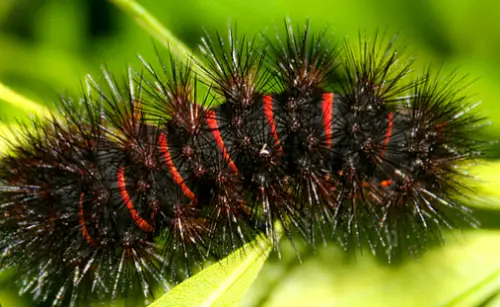
Known by its scientific name Hypercompe scribonia, the giant leopard caterpillar is a common black caterpillar with spikes found in the Southeast region of the United States. Its fluffy look and spiked body, which are notable for their noticeable red bands between sharp spines, can hurt people if the spikes puncture their skin. This creepy bug, which can reach a length of 5 cm, consumes willows, bananas, cherries, cabbage, maples, sunflowers, and violets.
Banded Woolly Bear Caterpillar
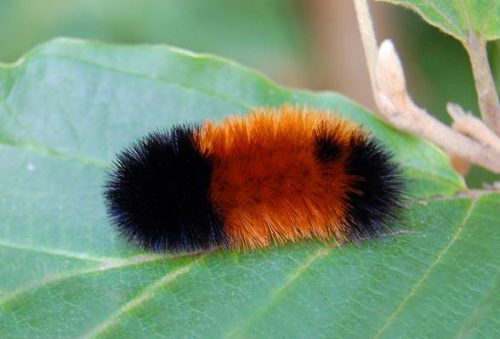
Pyrrharctia isabella, scientifically known as the Banded Woolly Bear Caterpillar, is a common black and brown fuzzy caterpillar found in Utah. It is distinguished by a wide rusty brown band encircling its black body. It is oblong in shape and has fuzzy spines, making it difficult to find the head and tail. In spite of their appearance, these caterpillars do not sting or contain any poison. They curl themselves into a ball when they feel threatened. These creepy-looking organisms can be found on plantains, asters, dandelion, goldenrod, and certain grasses. They can be identified by their characteristic brown band around the middle portion and two black bands at either end.
American Dagger Moth Caterpillar
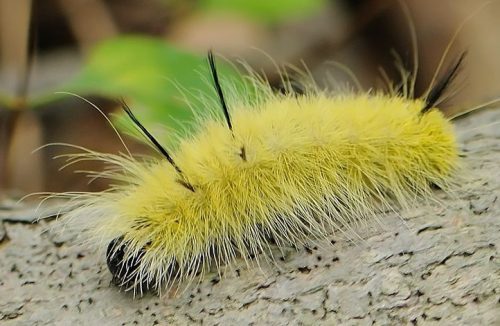
Acronicta Americana, the formal name for the American Dagger Moth Caterpillar, is a pale yellow moth caterpillar with long black pencil-like hairs. It is distinguished by its shiny black oval head and fuzzy yellow body. It also has spiky hairs on its head that, when touched, irritate the skin and cause rashes. These fuzzy caterpillars, which are found on hardwood trees such as alder, ash, elm, maple, oak, and willow, have two pairs of long pencil-hairs on their backs and stand out with their yellow feathery spines.
Tomato Hornworm Caterpillar
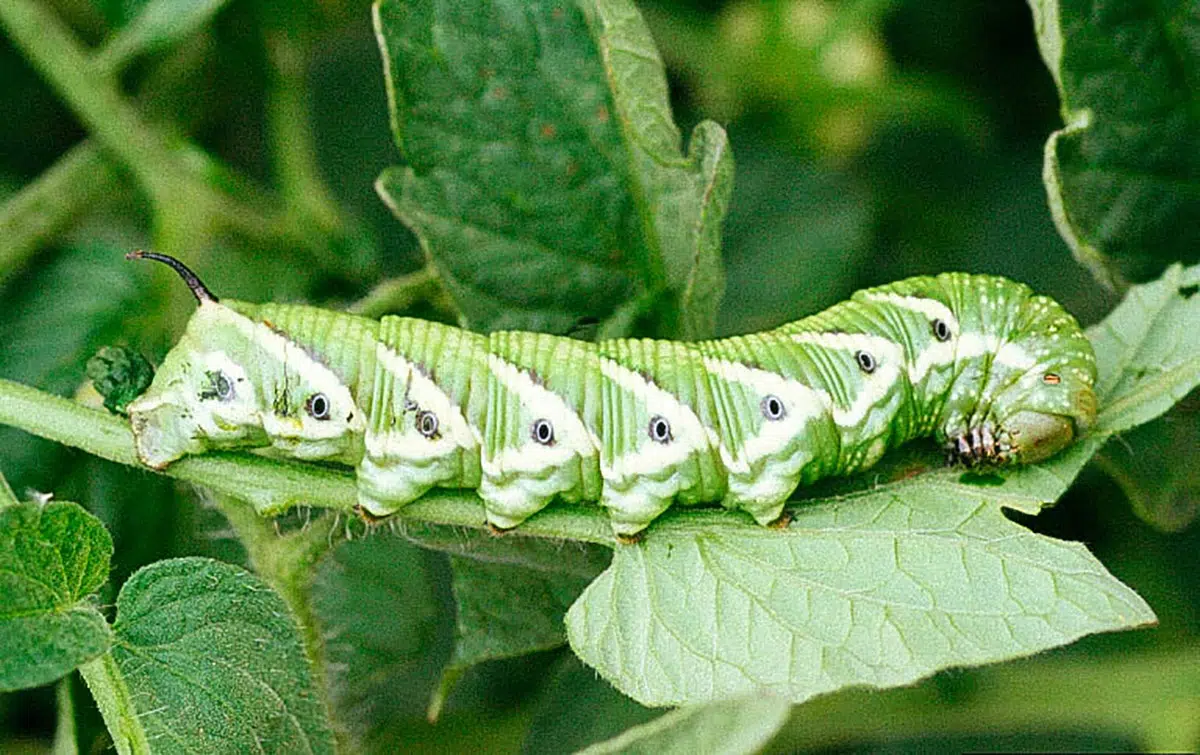
Manduca quinquemaculata, the scientific name for the tomato hornworm caterpillar, is a brilliant green garden pest with V-shaped patterns and rows of eyespots. It can be identified by the outgrowth of its pointed black tail, which resembles a horn. Its favorite food is tomato leaf. With its strong leaf camouflage, this up to 10cm long plant can be difficult to identify on tomato plants. It is advised to use chemical treatments to control infestations.
White Admiral Caterpillar
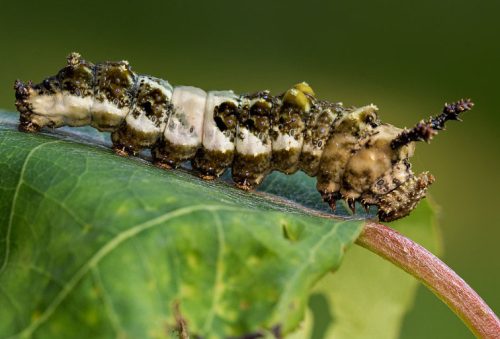
The Utah caterpillar known as the White Admiral, or Limenitis arthemis in scientific terms, blends in with bird droppings on branches to ward off predators. It can be recognized by its irregular white spots on its light green and brown body and its two long black horns on top of its head. It consumes leaves from willow, aspen, poplar, and birch trees. These caterpillars pupate to become vivid, iridescent blue and orange butterflies.
Common Pine Sawfly Caterpillar
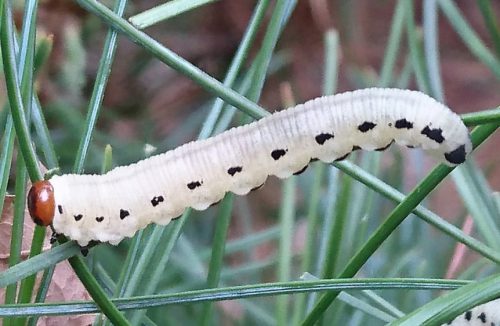
Diprion pini, the scientific name for the common pine sawfly caterpillar, is a light green caterpillar with black dots on its flanks and a single black line running along its back. This caterpillar, which is found on Scottish pines, pupates into a pine sawfly, a kind of wasp. One of its most distinctive characteristics is its rusty red head, which, before pupation, changes to a pale yellow and translucent state and is studded with artificial eyespots.
Eight-Spotted Forester Caterpillar
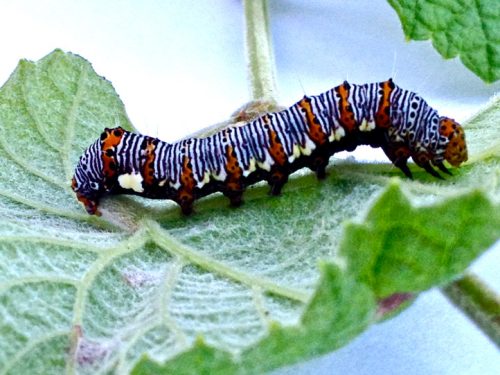
Alypia octomaculata, formally known as the Eight-Spotted Forester Caterpillar, is an orange caterpillar found in Utah that has black and white stripes all over its body. Every section has black tubercles that resemble tiny, spherical spots. Three sets of pointed forelegs, four sets of prolegs, and obvious feathery spines are distinguishing characteristics. This caterpillar, which is found on grape and Virginia creeper plants, is distinguished by its wide orange stripes with black spots, tufts of tiny spines, and striking black and white stripes.
Queen Butterfly Caterpillar
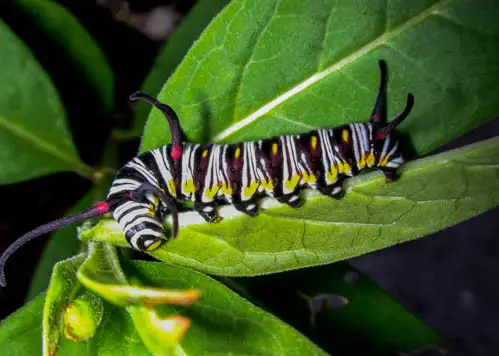
Danaus gilippus, the scientific name for the Queen Butterfly Caterpillar, has characteristic yellow dots on its sides and back in addition to black and white stripes. The head and tail have six enormous, meaty tentacles that are notable. It can grow up to 5 cm long and consumes mistflower, frogfruit, and milkweed plants. This caterpillar, which changes into a stunning queen butterfly, is recognized by its black and white stripes and yellow dots.
Black Swallowtail Caterpillar
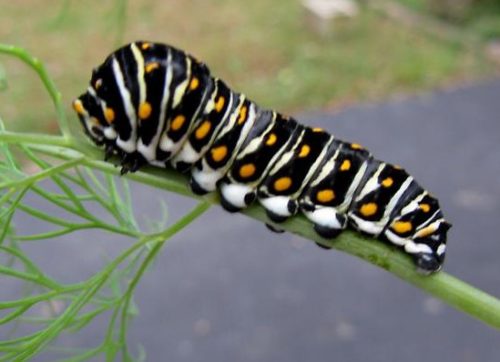
Papilio polyxenes, scientifically known as the black swallowtail caterpillar, is a huge green caterpillar found in Utah that has unique black and yellow stripes surrounding each segment. It’s not covered with spikes, spines, or horns like some caterpillars are. Its smooth body and vibrant colors scare away prospective predators, who mistake it for a threat. It feeds on milkweeds, carrots, dill, parsley, and fennel.
Monarch Caterpillar
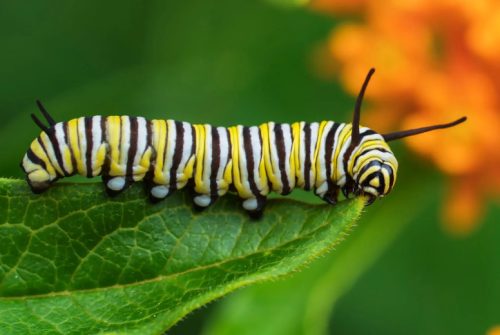
The Utah-native Monarch Caterpillar, scientifically known as Danaus plexippus, is a striped and horned caterpillar with vivid yellow, white, and black markings all over its body. Each segment is identified by prominent bands of color, while the head and tail are distinguished by long black horns and shorter ones, respectively. With black forelegs and white dots on their prolegs, they can grow up to 5 cm. These caterpillars build up poisonous materials in their bodies because they only eat milkweed plants.
Hickory Horned Devil Caterpillar
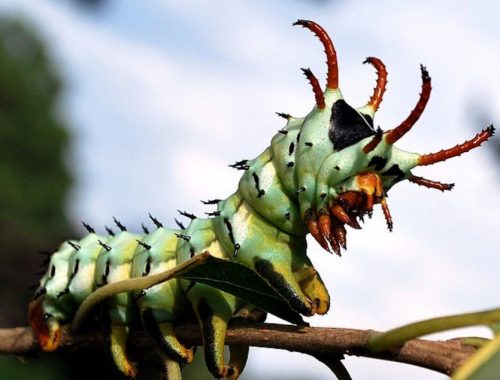
Citheronia regalis, the scientific name for the strange yet benign caterpillar known as the Hickory-Horned Devil, is found in Utah. Its bluish-green body is ornamented with black points on curving, spiky horns, and it consumes sweetgum, walnut, hickory, and pecan leaves. Easily identified by its frightening crimson horns and orange-red head, this enormous bug pupates to become a majestic moth.
Stinging Rose Caterpillar
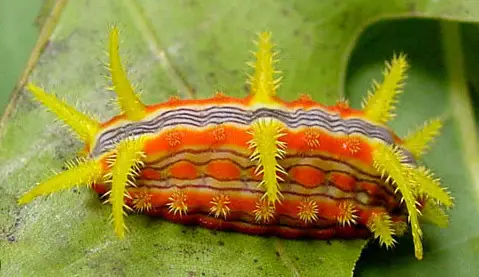
Scientifically known as Parasa indetermina, the Stinging Rose Caterpillar is a vibrant and poisonous species that can be found from New York to Utah on the East Coast. Its unique features include jagged spikes along the back that resemble horns and bunches of spines down the sides. Its body is yellow or orange-red in color and is decorated with thin bands of purple stripes. Up to 2.5 cm in length, these caterpillars consume dogwood, poplars, hickories, oaks, and rose bushes as their food source. Because of their poisonous spines, handling them should be done carefully as it may cause skin irritation.
Spiny Oak Slug Caterpillar
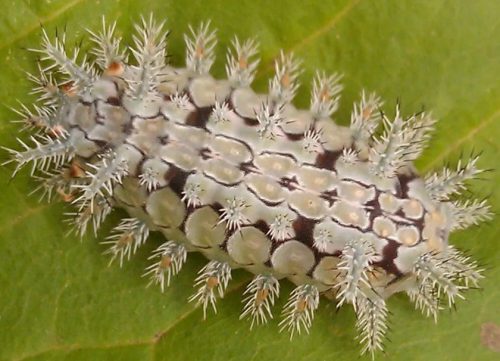
Euclea delphinii is the scientific name for the colorful, venomous caterpillar known as the Spiny Oak Slug Caterpillar. It is covered with sharp spikes. Four pairs of upward-pointing spiked orange horns and two orange bands with circular white and green markings along the back are distinguishing characteristics. The venom in these spikes has the potential to irritate skin. Found on a variety of deciduous shrubs and trees, they eat the leaves of many different trees and shrubs, including blueberries, beech, poplar, hackberry, oak, maple, and basswood.
Azalea Caterpillars
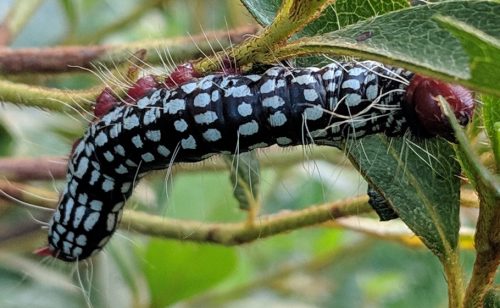
The scientific name for Azalea caterpillars is Datana major. They are smooth, black caterpillars from Utah with vivid green bands encircling their plump, black bodies. A rounded orange head and tail segment are among its striking characteristics. These ravenous larvae, which are distinguished by their green, black, and orange patterns, are dangerous to the leaves of oak, blueberry, and apple trees.
Gulf Fritillary Caterpillar
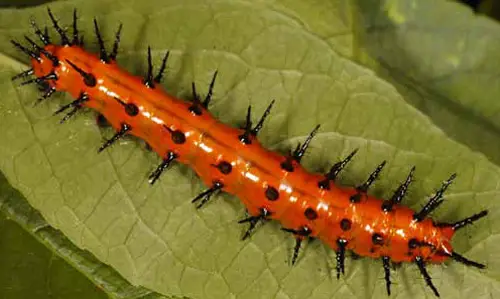
Dione vanillae, the scientific name for the Gulf Fritillary Caterpillar, is distinguished by the spiky spikes surrounding its orange segments. Grayish-black stripes that run longitudinally over its back are another distinguishing trait that makes it easy to identify. These caterpillars, which are found on passion flowers, have a smooth orange body with prominent spines and blackish stripes.
Spicebush Swallowtail Caterpillar
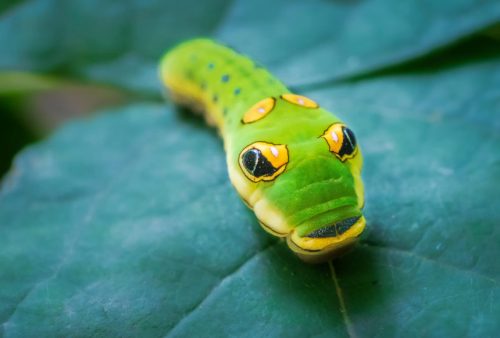
Papilio Troilus, the scientific name for the Spicebush Swallowtail Caterpillar, is a unique green Utah caterpillar with huge eye patterns on its head. Its color changes from brown to green to yellowish in the ultimate growing stage. Each segment has unique circular patterns made of blue color. Notably, eyespot marks on the skull are formed by black circles encircled by yellow rings. This caterpillar has distinct characteristics that help identify it; it can be found on spicebush and sweet bay.
Redhumped Caterpillar
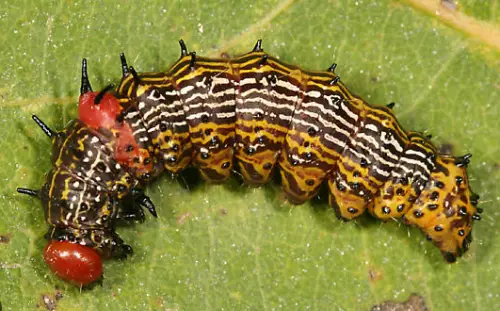
The name Schizura concinna, or Redhumped Caterpillar, comes from the red hump on its back. It is distinguished by its reddish-pink circular heads, feathery spines, soft horn-like growths, and stripes of yellow and white. It consumes the apricot, birch, almond, and apple trees. This Utah caterpillar is easily identified by its unique traits, which include a shiny black body covered in bands of prickly spikes.
Cloudless Sulphur Caterpillar
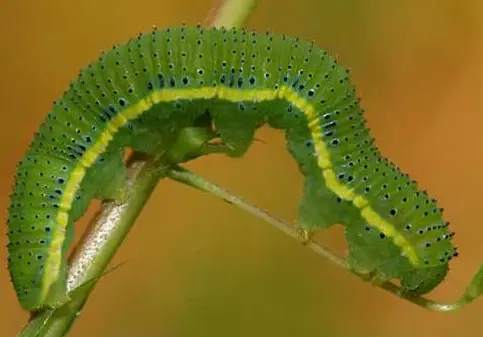
Phoebis sennae, the scientific name for the Cloudless Sulphur Caterpillar, is a pale green caterpillar with black raised spots that form small spines. The prolegs and abdomen have soft yellowish spines covering them, and a pale yellow line running along its sides adds another characteristic. These caterpillars, which are found on wild plants vulnerable to Maryland conditions, are distinguished by their green bodies with bluish-black spots, light yellowish small spines, and a yellow lateral stripe running along their sides.
Red Admiral Caterpillar
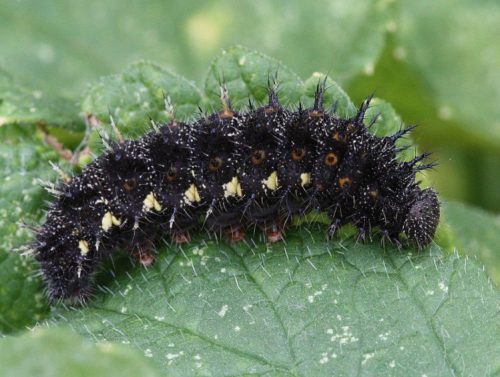
With fleshy spines and white dots all over its body, the spiky black Red Admiral caterpillar (scientifically known as Vanessa atalanta) is a caterpillar native to Utah. Caterpillars measuring up to 2.5 cm in length, they feed on stinging nettle plants before changing into a grayish-brown tint with dots of dark red or brown along the sides. Their characteristic yellow bodies with black and white stripes are on full display as they transform into eye-catching black and red butterflies following pupation.
Tiger Swallowtail Caterpillar
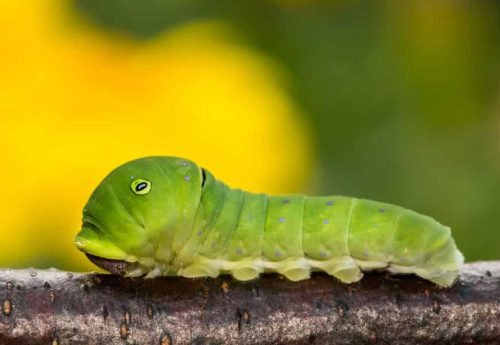
Papilio glaucus, the scientific name for the Tiger Swallowtail Caterpillar, is a smooth-bodied, dark green caterpillar with eye-like patterns on both sides of its head. Its defense mechanism on its head, which mimics a forked snake tongue and serves to frighten away possible dangers, is toxic to birds and tiny animals. This caterpillar, which is found on green ash, sweet bay, black cherry, and Carolina ash trees, is distinguished by its dark green abdomen and peculiar eye-like patterns.
Cecropia Moth Caterpillar
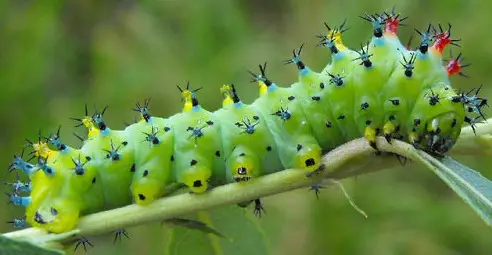
Hyalophora cecropia, the scientific name for the Cecropia Moth Caterpillar, is a huge, ridged segmented caterpillar found in Utah that has rows of orange and blue tubercles on it. Its black spikes contrast sharply with its lime-green body. These eye-catching green caterpillars turn into stunning brown moths, which are typically seen in April and May. You can spot them on ash, birch, box elder, alder, elm, maple, and poplar trees by looking for the visible segments that have lots of orange tubercles, black spikes, and rows of blue and yellow fleshy lumps.
Cabbage Looper Caterpillars
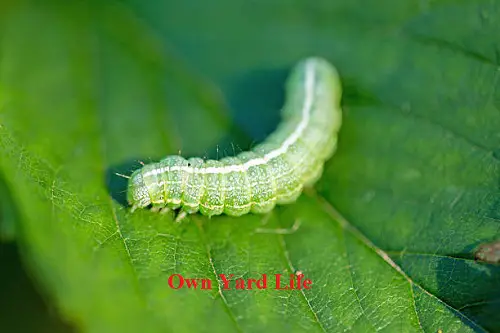
In Utah, the Cabbage Looper Caterpillars, or Trichoplusia ni as they are scientifically called, are common in the spring and summer. These omnivorous animals, which can be identified by their looping gait, have an incredible appetite and can eat up to three times their own weight each day. They can reach a length of 4 cm and consume cabbage, tomato, soybean, and pepper plants. Their bodies are lime green or yellow green in color. When moving, their motion loops, making them stand out.
Luna Moth Caterpillar
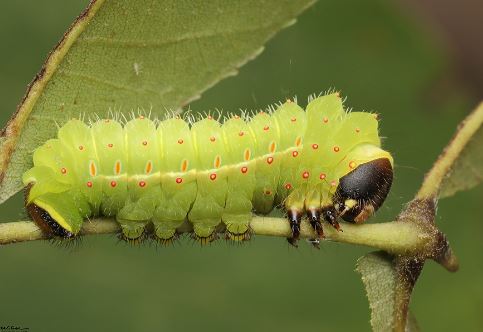
Actias luna, the scientific name for the Luna Moth Caterpillar, has a lime-green body with red dots on the back and tufts of tiny spines. Known to elevate the front portion of their bodies when moving, these caterpillars consume maple, birch, walnut, hickory, and American sweet gum trees. Their large appetite has caused them to grow up to 9cm long. They are distinguished by their brown head, three pairs of brown forelegs, and a brilliant red dot line that runs lengthwise.
Forest Tent Caterpillars
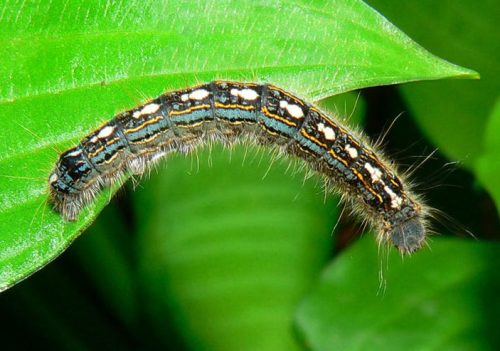
The scientific name for the Utah caterpillar known as the Forest Tent Caterpillar is Malacosoma disstria. It has a dark body with yellow lines, blue bands on the sides, and white spots. This caterpillar, which is easily seen in the spring and summer, is distinguished by the feathery spines that run along its sides. Its distinctive blackish-brown color and the lengthwise bands of blue, yellow, and black on its back help identify it. It feeds on the leaves of willow, oak, birch, elm, and maple trees respectively.
Zebra Longwing Caterpillar
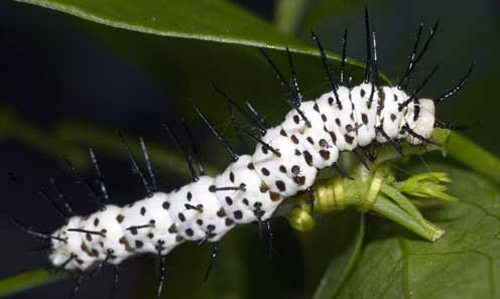
Known by its official name Heliconius charithonia, the Zebra Longwing Caterpillar is a caterpillar that is typically found in Utah and other Southern states. It has long, black, fleshy spikes and is pale-gray in color. The caterpillar, which has delicate spines all over it, consumes passionflower plants and builds up poisonous compounds throughout its body. As a protective measure, the venom gives predators a bad taste.
Polyphemus Moth Caterpillar
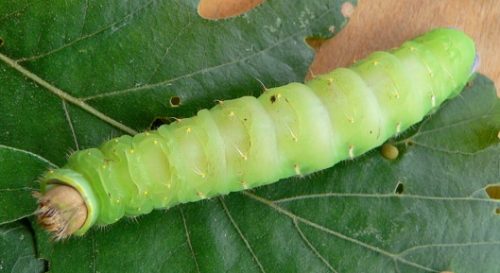
The scientific name for the Polyphemus Moth Caterpillar is Antheraea polyphemus. It is a light green caterpillar with vivid red spots around each segment that spins like silk. Distinguished characteristics are plumpness and prominent spines protruding from red tubercles. Juvenile caterpillars are brilliant yellow at first and progressively turn green as they mature. Identification traits of this caterpillar include a bright green translucent body with rows of red dots or silver spiky spots around its segments. It is found on apple, ash, birch, elm, hazel, maple, rose, and dogwood trees.
Evergreen Bagworm
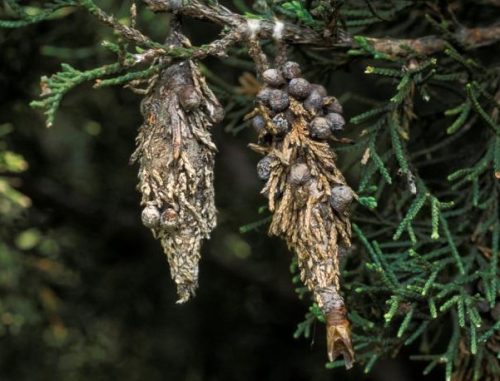
In Utah, the Evergreen Bagworm is a glossy, dark brown or black caterpillar that is a member of the Psychidae family. Its difficult-to-spot protective bag-like structures constructed of tree leaf are its distinguishing trait. Living inside their cocoon bags, these caterpillars infest and quickly defoliate beautiful backyard trees like black locust, elm, maple, poplar, oak, and willow.
Yellow Forester Moth Caterpillar
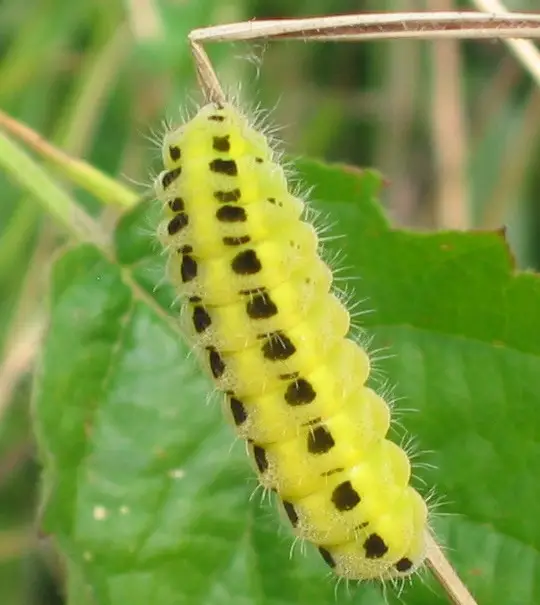
Scientifically speaking, the Yellow Forester Moth Caterpillar is a bright yellow or yellowish-green Utah caterpillar with rows of black spots on its back. It is a member of the Zygaenidae family. It has prickly tufts on its sides and back and consumes herbaceous plants, especially Carolina laurelcherry. These caterpillars, which may reach a length of 12.5 cm, have unusual brilliant yellow bodies with black lines running down their sides and backs.
Long-Tailed Skipper Caterpillar
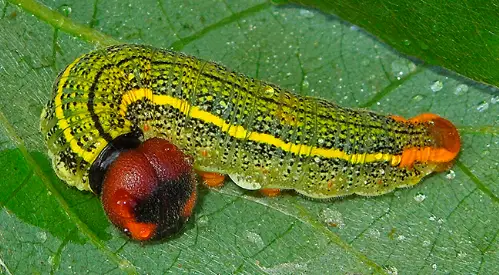
The Long-Tailed Skipper Caterpillar, scientifically named Urbanus proteus, is a large green, slug-like caterpillar with rings of yellow spots around the segments and a lateral greenish-yellow line along its back. Often called the bean leafroller, it has an orange-patterned tail and a black, spherical head. Mature caterpillars acquire pinkish markings and turn a pale green color. A ball-like head, yellow markings, and orange prolegs are characteristics that help identify this species, which is found on beans, peas, hog peanuts, and wisteria vines.
People Who Read This Also Read:



